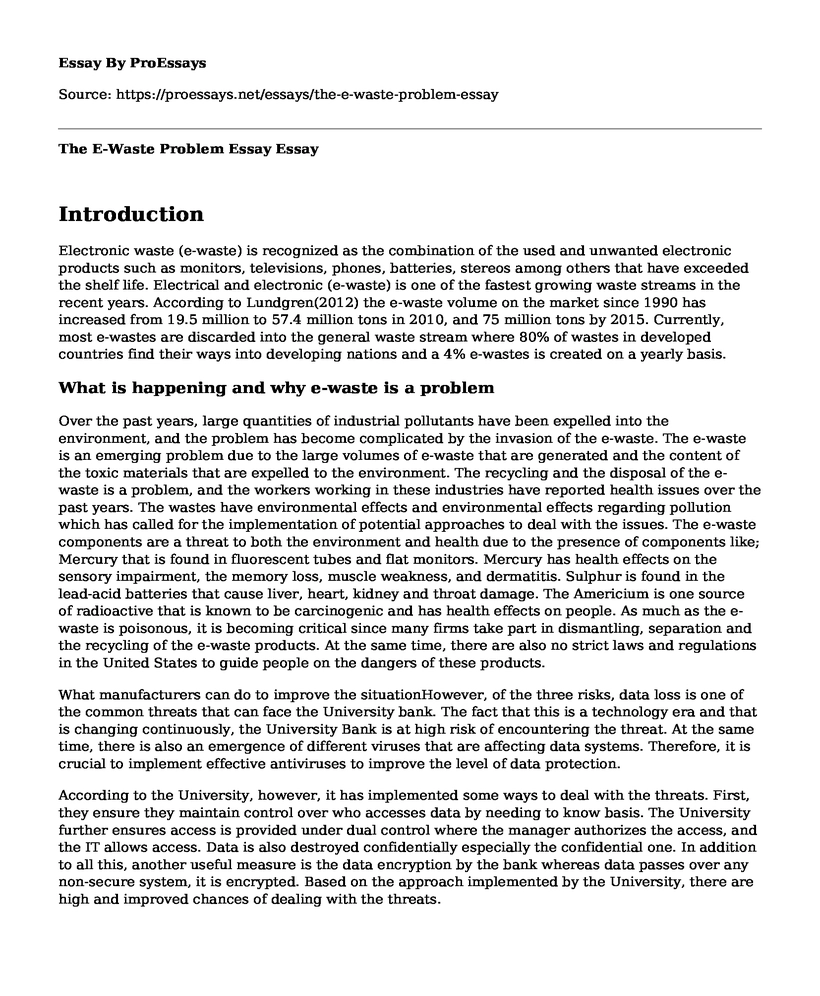Introduction
Electronic waste (e-waste) is recognized as the combination of the used and unwanted electronic products such as monitors, televisions, phones, batteries, stereos among others that have exceeded the shelf life. Electrical and electronic (e-waste) is one of the fastest growing waste streams in the recent years. According to Lundgren(2012) the e-waste volume on the market since 1990 has increased from 19.5 million to 57.4 million tons in 2010, and 75 million tons by 2015. Currently, most e-wastes are discarded into the general waste stream where 80% of wastes in developed countries find their ways into developing nations and a 4% e-wastes is created on a yearly basis.
What is happening and why e-waste is a problem
Over the past years, large quantities of industrial pollutants have been expelled into the environment, and the problem has become complicated by the invasion of the e-waste. The e-waste is an emerging problem due to the large volumes of e-waste that are generated and the content of the toxic materials that are expelled to the environment. The recycling and the disposal of the e-waste is a problem, and the workers working in these industries have reported health issues over the past years. The wastes have environmental effects and environmental effects regarding pollution which has called for the implementation of potential approaches to deal with the issues. The e-waste components are a threat to both the environment and health due to the presence of components like; Mercury that is found in fluorescent tubes and flat monitors. Mercury has health effects on the sensory impairment, the memory loss, muscle weakness, and dermatitis. Sulphur is found in the lead-acid batteries that cause liver, heart, kidney and throat damage. The Americium is one source of radioactive that is known to be carcinogenic and has health effects on people. As much as the e-waste is poisonous, it is becoming critical since many firms take part in dismantling, separation and the recycling of the e-waste products. At the same time, there are also no strict laws and regulations in the United States to guide people on the dangers of these products.
What manufacturers can do to improve the situationHowever, of the three risks, data loss is one of the common threats that can face the University bank. The fact that this is a technology era and that is changing continuously, the University Bank is at high risk of encountering the threat. At the same time, there is also an emergence of different viruses that are affecting data systems. Therefore, it is crucial to implement effective antiviruses to improve the level of data protection.
According to the University, however, it has implemented some ways to deal with the threats. First, they ensure they maintain control over who accesses data by needing to know basis. The University further ensures access is provided under dual control where the manager authorizes the access, and the IT allows access. Data is also destroyed confidentially especially the confidential one. In addition to all this, another useful measure is the data encryption by the bank whereas data passes over any non-secure system, it is encrypted. Based on the approach implemented by the University, there are high and improved chances of dealing with the threats.
References
Bidgoli, H. (2006). Handbook of Information Security, Information Warfare, Social, Legal, and International Issues and Security Foundations (Vol. 2).
John Wiley & Sons.Buscheck, A. J. (2012). A Formula for the Judicial Reorganization of Public Service Corporations. Colum. L. Rev., 32, 964.
Cite this page
The E-Waste Problem Essay. (2022, Jul 01). Retrieved from https://proessays.net/essays/the-e-waste-problem-essay
If you are the original author of this essay and no longer wish to have it published on the ProEssays website, please click below to request its removal:
- Research Paper on Hurricane Intensity in the Recent Past
- Effectiveness of State Pollution Prevention Programs and Policies Essay
- Access to Clean Water in South America Essay Example
- Essay on Environmental Factors and Aircraft Performance: A Debated Issue
- Essay Example on Air Pollution: Effects on Environment & Health
- The Caribbean Sea: Pollution From Industrialization, Globalization, & Urbanization - Essay Sample
- Unraveling Climate Change: Impact on Weather, Cryosphere, Ocean Ecosystems, and Human Society







